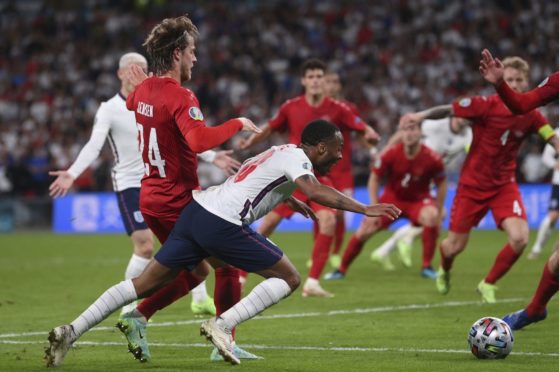To VAR or not to VAR? It’s a question football fans find themselves asking, particularly after England’s Euro 2020 penalty controversy. But technology in sport will never be perfect – because sports was never just about the results.
Innovation and pushing the limits of the human body has long been a part of athletic achievement.
This includes improving technological advancements and gathering more data in a variety of sports.
Collecting as much data as possible, much like the fitness trackers we wear on our wrists, can be beneficial for athletes in perfecting their performance.
But the introduction of technology during competitions has been more contentious.
The classic example is Video Assistant Referees (VAR) in football.
Most recently, VAR was used in the Euro 2020 semi-final to confirm the decisive penalty that took England and not Denmark to the finals.
The outcry that followed raised questions as to whether the decision, as well as the use of the technology, was justified.
Challenges to using sports technologies go beyond football.
Another example is Hawk-Eye in tennis, the technology used to digitally recreate the line of the ball to determine where it bounced.
Wimbledon drama-free, but what of the future?
Although there were no major mishaps at Wimbledon, the use of the technology raises questions on clay courts in particular, where the ball’s mark is clearly imprinted on the ground.
If Hawk-Eye says the ball is out, but its mark on the court says it’s in, what should the umpire do?
Even in less controversial situations, where the data does not impact the results, the inclusion of data-driven graphics have been questioned.
Amazon Web Services use their machine-learning tools to power broadcast graphics in Formula One.
While the organisers have argued that the visuals provide more insight into the cars on the track, others have questioned their accuracy and usefulness as the extra information could spoil the result of the race.
Sport technology has its benefits
When it comes to deploying technologies during competitions, being able to provide more camera angles and perspectives not captured by the naked eye can limit human error and provide more entertainment for viewers.
The introduction of technologies can also be very useful.
For example, motion-capture systems in cricket are used by umpires to determine whether bowlers have overbent their arm outside of the rules.
But tech can also take away
On the other hand, for world class athletes, these tiny margins that are decided by technologies can dramatically affect whether they win or lose.
For viewers, if the technologies are deemed to be used poorly or do not provide meaningful information about the sport, they could detract from the main event.
Regardless of whether certain applications of technology in sport are warranted, even if the data is 100% accurate, when we react to sporting technologies, we rarely do it without emotion.
Crucially, whether we think a decision was right depends on things outside of the realm of data.
Is our favourite athlete or team competing?
How familiar are we with the sport?
Does this particular judgement make a difference to the result?
All these factors change how we perceive the data and how willing we are to let a decision slide.
So why do we still need referees?
Sports organisers know this.
Beyond the huge amounts of research done to decide whether to implement new technologies or use certain types of data, when new innovations are introduced, they often have to be requested (usually by the umpire or referee) and used to challenge decisions (by the athletes).
In many instances, only decisions that clearly point to the referee’s fault will be overridden by technology.
If these heavily invested technologies are so sophisticated, as many technologies we use in our daily lives are, why would we still rely on human decision-making in sports?
Sport’s success and enjoyment does not just come down to the result or data
It’s because we recognise the human side of sports, including the expertise and knowledge of the athletes and referees.
For the viewer, sport’s success and enjoyment does not just come down to the result or data.
Even in technologically driven sports such as Formula One that require high tech simulators and data analysis to maximise car performance, it’s the drivers and their race craft that bring fans to the stands.
Silverstone's returning fans saw Max Verstappen set the pace in FP1 ⏱#BritishGP 🇬🇧 #F1https://t.co/h1CsR287QM
— Formula 1 (@F1) July 16, 2021
Excellence means “outperforming the car” to go beyond the physical limits of the machine.
Ultimately, sports are about our pride when our team wins, our unwavering support for the players even when they lose, and is an expression of our identity.
When Scotland fans travelled down to London, a win would have been the icing on the cake, but the reason Scots went to Wembley was to show other teams that our cake is the best.
Regardless of what you think about VAR or sport technologies, when we mourn the heartbreak of our favourite team or player losing, no amount of record-breaking data will do.
The enjoyment of sports come from our sharing of emotions with friends and family in person at the pub or at home.
Then doing it all again next weekend, whatever the result.
Janis Wong is a Phd researcher in computer science at St Andrews University.


